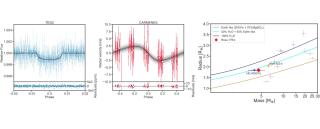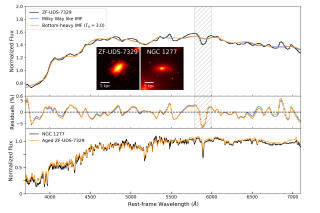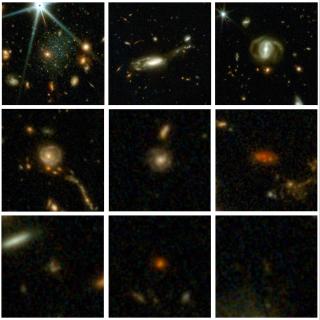All stellar-mass black holes have hitherto been identified by X-rays emitted from gas that is accreting onto the black hole from a companion star. These systems are all binaries with a black-hole mass that is less than 30 times that of the Sun. Theory predicts, however, that X-ray-emitting systems form a minority of the total population of star–black-hole binaries. When the black hole is not accreting gas, it can be found through radial-velocity measurements of the motion of the companion star. We report here radial-velocity measurements taken over two years of the Galactic B-type star, LB-1. The star was initially discovered during a monitoring campaign with the 4-m telescope LAMOST and subsequently studied in more detail with the 10-m class telescopes GTC and Keck. We find that the motion of the B star and a superimposed Hα emission line (see figure) require the presence of a dark companion with a mass of 68 solar masses, which can only be a black hole. The long orbital period of 78.9 days shows that this is a wide binary system. For comparison, black holes detected in X-ray binaries have masses in the range 5-15 solar masses. On the other hand, gravitational-wave experiments have detected black holes with several tens of solar masses. However, the formation of a ~70 solar mass black hole in a high-metallicity environment is extremely challenging within current stellar evolution theories. This would require a significant reduction in wind mass-loss rates and overcoming the pair-instability supernova phase, which limits the maximum black hole mass to less than ~50 solar masses. Alternatively, the black hole in LB-1 might have formed after a binary black hole merger or other exotic mechanisms.
a) radial velocity curves and orbital fits for the B-star (purple) and its dark companion (orange), the latter extracted from the wings of the Hα emission (panel c). b) Residuals obtained after subtracting the best orbital models from the velocity points.
It may interest you
-
 The TESS (Transiting Exoplanet Survey Satellite) mission has discovered many exoplanet candidates that need to be confirmed and characterized from the ground. One of them orbits Ross 176, a K-type dwarf star, where we have identified a promising hot “water-world” candidate. Using spectroscopic observations with the CARMENES instrument, we confirmed the planetary nature of the signal detected by TESS and estimated the planet’s mass. To improve the analysis, we applied an advanced statistical method called Gaussian Process, which allowed us to separate the star’s own variability (quite strongAdvertised on
The TESS (Transiting Exoplanet Survey Satellite) mission has discovered many exoplanet candidates that need to be confirmed and characterized from the ground. One of them orbits Ross 176, a K-type dwarf star, where we have identified a promising hot “water-world” candidate. Using spectroscopic observations with the CARMENES instrument, we confirmed the planetary nature of the signal detected by TESS and estimated the planet’s mass. To improve the analysis, we applied an advanced statistical method called Gaussian Process, which allowed us to separate the star’s own variability (quite strongAdvertised on -
 Observations made with the James Webb Space Telescope (JWST) have revealed a larger-than-expected number of massive galaxies when the Universe was still young. The focus of this study is precisely one of these galaxies, ZF-UDS-7329. It is a very compact object, and its spectrum suggests that it formed at a very early stage, when the Universe was around 2 billion years old. According to theoretical predictions, these objects first formed a generation of stars at the center of their dark matter halos and subsequently grew by merging with other halos. However, due to the random nature of theseAdvertised on
Observations made with the James Webb Space Telescope (JWST) have revealed a larger-than-expected number of massive galaxies when the Universe was still young. The focus of this study is precisely one of these galaxies, ZF-UDS-7329. It is a very compact object, and its spectrum suggests that it formed at a very early stage, when the Universe was around 2 billion years old. According to theoretical predictions, these objects first formed a generation of stars at the center of their dark matter halos and subsequently grew by merging with other halos. However, due to the random nature of theseAdvertised on -
 The largest observation program of the James Webb Space Telescope (JWST) has released its data: nearly 800,000 galaxies observed in unprecedented detail. COSMOS-Web thus offers the most extensive and deepest view of the universe ever obtained. In this data release, the Instituto de Astrofísica de Canarias (IAC) has played a key role, performing the morphological classification of more than half a million galaxies using neural networks, a crucial contribution to explore how galaxies form and evolve over cosmic time. COSMOS-Web was the largest General Observer program selected for Cycle 1 ofAdvertised on
The largest observation program of the James Webb Space Telescope (JWST) has released its data: nearly 800,000 galaxies observed in unprecedented detail. COSMOS-Web thus offers the most extensive and deepest view of the universe ever obtained. In this data release, the Instituto de Astrofísica de Canarias (IAC) has played a key role, performing the morphological classification of more than half a million galaxies using neural networks, a crucial contribution to explore how galaxies form and evolve over cosmic time. COSMOS-Web was the largest General Observer program selected for Cycle 1 ofAdvertised on
